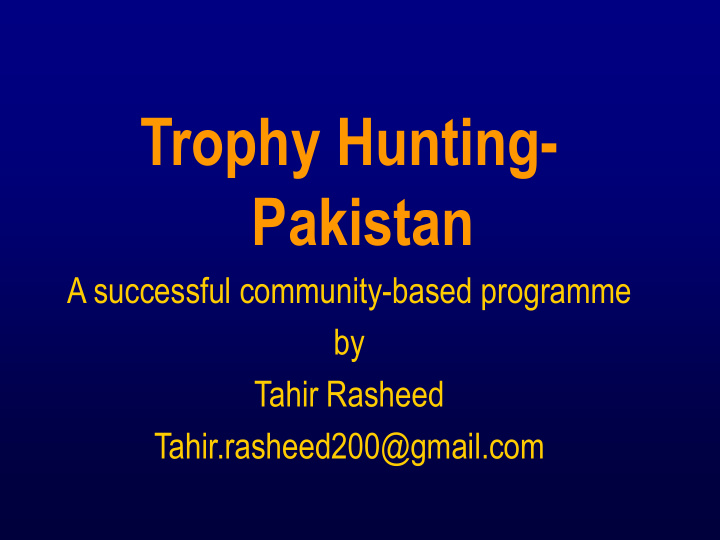



Trophy Hunting- Pakistan A successful community-based programme by Tahir Rasheed Tahir.rasheed200@gmail.com
The wild ungulates of Pakistan Pakistan is the most important country for Caprinae conservation Home to 7 species with 11 sub-species Occupying an array of habitats from the hills in the southern deserts to the high alpine areas of the Himalaya Most now survive in small scatted populations Currently 10 out of the 11 sub-species are “ Threatened ” , with eight classed as “ Endangered ” Source: Shackleton, 1997
The wild ungulates had suffered from . . . Subsistence and sport hunting Habitat fragmentation and disturbance Grazing competition with domestic stock Disease transmission from domestic stock Depressed breeding (Inbreeding depression)? Others e.g. sophisticated weapons?
What was needed? Protection and sustainable use Protection is only possible with the active involvement of the custodian communities in collaboration with conservation GOs and NGOs . Sustainable use follows the protection efforts and species survival in a certain environment.
Launched: a community-based Trophy Hunting programme A viable tool for conserving Biological Diversity while providing financial incentives to the custodian communities and respective departments
Trophy Hunting initiatives in Pakistan Straight-horned markhor and Afghan urial trophy hunting programme in Torghar initiated by TCP Pir Panjal markhor trophy hunting programme in NWFP initiated by NWFP Wildlife Departme nt Punjab urial trophy hunting programme in Kalabagh Conservation Area (Private) Sindh ibex trophy hunting programme initiated by Sindh Wildlife Department Sindh ibex and Afghan urial (Gad) trophy hunting programme in Dureji Game Area (Private) Himalayan ibex and Astore markhor community-based trophy hunting programme in NAs (Pioneers)
Utilisation of funds from Sustainable Trophy Hunting Generates substantial funds that could be used for conservation and developmental activities such as: Habitat protection Population monitoring Law enforcement Research or management programmes Investment in socio-economic development Equally important, the revenues from trophy hunting can provide a strong incentive for conservation or habitat protection by demonstrating the economic worth of Caprinae to local people
What is needed in the international market Reliable scientific census data Government approval for quotas Quota allocation 12 months in advance Effective government monitoring and endorsement of the programme “ One window ” procedure for import/export of weapons and export of trophy Trained and registered professional guides and porters Well-established Outfitter ’ s Association Formal government procedure for any complaints e.g. exit questionnaire
Efforts to make it a successful programme….
Major Steps: 1. Surveys completed 2. Quotas recommended and approved by Government by CITIES authority (16 members) 3. Hunts sold and Licenses issued 4. Clearances sought 5. Arms permits issued 6. Logistics in place
Major Steps: 1. Access routes checked 2. Scouting parties in field 3. Government rep joins hunting party 4. Foreign visitor registration complete
Major Steps: 1. Scouting parties report back 2. Access routes are checked
What aspects of the programme needed attention specifically?
General Distinguish clearly between: + Licence fees + Trophy fees + Outfitting costs
Federal Level + Compliance of the TH procedures + Streamline sporting firearm import / export procedures + Enhance customs control (CITES) + Improve appearance of export permits
Province/Territorial Level + Enhance monitoring + Fix licence fees for each species + Publish quotas 12 months in advance to facilitate marketing
Torghar a Case Study 1984: The idea of conservation in Torghar area conceived 1985: Torghar Conservation Program (TCP) initiated 1994: Society for Torghar Environmental Protection (STEP) established and registered
SUSG’s VISION The conservation of Markhor and Urial, through sustainable use is the first step to conserving the overall biodiversity of Torghar.
Funded by trophy hunting fees Trophy hunting is not a goal , but a means to fund the conservation program.
Data from Johnson (1997), Frisina et al. (1998), Frisina (2000), Shafique (2006)
BENEFITS TO LOCAL COMMUNITY Since 1986 the trophy harvest has brought in a total income of US$1,716,800 US$ 287,200 paid to the government of Balochistan.
Utilisation of funds: WATER SUPPLY With joint support from UNDP,SUSG- CAsia STEP has developed water tanks, wells, channels, and storage dams.
IMPRO ROVED D LI LIVESTO TOCK CK SUSG-CAsia has trained 10 veterinary and agriculture technicians. Maintain fewer but healthier livestock.
IMPROVED AGRICULTURE SUSG-CASia/STEP has assisted with development of agricultural fields and provided fruit and firewood sapling trees for orchards.
Management History of the Tooshi-Shasha Community Conserved Areas Case Study 2 • Tooshi: Foothills of Hindukush Mountain • Northeast of Chitral town at a distance of 7 KM. • Tooshi Community Game Reserve covers more than 12 villages (area 20,000 ha) • Dry-temperate ecosystem • The Game Reserve is also the habitat of Snow Leopard, Markhor, Snow Partridge, Lynx, Wolves, etc. • The total population of Markhor in the area is estimated round 600 .
Funds Generated in Tooshi Trophy hunting since 1987 Formally in 1997 the Govt. coordinated trophy harvest started Markhor trophy fee 87,000 US$ Resource share formula: 80:20 80% Spent on community infrastructure
American Lady hunting in Tooshi, 2009
Development through Conservation
Celebrations . . .
Celebrations . . .
Thanks
Recommend
More recommend